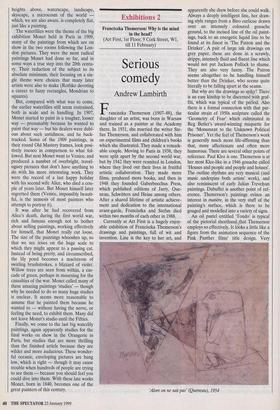Exhibitions 2
Serious comedy
Andrew Lambirth
Franciszka Themerson (1907-88), the daughter of an artist, was born in Warsaw and trained as a painter at the Academy there. In 1931, she married the writer Ste- fan Themerson, and collaborated with him on experimental films and children's books which she illustrated. They made a remark- able couple. Moving to Paris in 1938, they were split apart by the second world war, but by 1942 they were reunited in London, where they lived out their lives in fruitful artistic collaboration. They made more films, produced more books, and then in 1948 they founded Gaberbocchus Press, which published editions of Jarry, Que- neau, Schwitters and Heine among others. After a shared lifetime of artistic achieve- ment and dedication to the international avant-garde, Franciszka and Stefan died within two months of each other in 1988.
Currently at Art First is a hugely enjoy- able exhibition of Franciszka Themerson's drawings and paintings, full of wit and invention. Line is the key to her art, and apparently she drew before she could walk. Always a deeply intelligent line, her draw- ing style ranges from a Biro curlicue drawn over an intensely coloured gouache ground, to the incised line of the oil paint- ings, back to an energetic liquid line to be found at its finest in 'The Patron and the Drinker'. A pair of large ink drawings on grey paper, these are done in a scrawly, drippy, intensely fluid and fluent line which would not put Jackson Pollock to shame. They are also very funny. The Patron seems altogether to be handling himself better than the Drinker, who seems quite literally to be falling apart at the seams.
But why are the drawings so spiky? There is an easy kinship to be discerned with graf- fiti, which was typical of the petiod. Also there is a formal connection with that par- ticular strain of 1950s sculpture called the `Geometry of Fear' which culminated in Reg Butler's award-winning maquette for the 'Monument to the Unknown Political Prisoner'. Yet the feel of Themerson's work is generally much more life-affirming than that, more affectionate and often more humorous. There are several other points of reference. Paul Klee is one. Themerson is at her most Klee-like in a 1946 gouache called `Houses and people and people and houses'. The outline rhythms are very musical (and music underpins both artists' work), and also reminiscent of early Julian Trevelyan paintings. Dubuffet is another point of ref- erence. Themerson's paintings evince an interest in rnatiere, in the very stuff of the painting's surface, which is there to be gouged and modelled into a variety of signs.
An oil pastel entitled 'Tondo' is typical of the pictorial shorthand that Themerson employs so effectively. It looks a little like a figure from the animation sequence of the Pink Panther films' title design. Very Alors on ne sait pas' (Queneau), 1954 French — like Inspector Clouseau himself. If these drawings have a period charm (and it's closer probably to the 1950s than the 1960s) this should not relegate them as art to some forgettable pigeonhole. After all, does this work have anything to offer the youth of today? Yes — an exemplary pas- sion and a resonating belief in the life of the mind.
There's a series of small wiry pen draw- ings of 'Private Drinkers' — the tearful, the guilty, the poet. Not only do they repay a great deal of looking, but they are a bar- gain at £300 or £400 a piece. Themerson evidently had a special relationship with music and musicians, and she catches many performers thoroughly in the act. Here a pianist, there a cellist or piper. She finds it difficult to resist a visual pun; a double- bass player plaits his strings, or a violinist plays his moustache. (An excellent laminat- ed paperback simply entitled Music repro- duces 96 pages of black and white Themerson drawings, price £10 from the gallery, or from the Themerson Archive, 12 Belsize Park Gardens, London NW3 4LD.) There are several paintings in this delightful exhibition, mostly done in a vari- ety of off-white hues, the oil paint slabbed and spread like royal icing, with blushes or stains of deeper colour underneath. They demonstrate an extension of Themerson's drawing, often comprising a network of lines, the paint deeply scored or fingered sensually. -A painting from 1950, called `Portrait of the artist as a blue spot', has one of the finest titles I've come across in a long while. It is run a close second by 'Why is the mind in the head?', an oil from 1954, which gives the exhibition its overall title. A prominent groin area in this picture sug- gests an alternate site for the brain.
Some of the images are more troubled than others. The endearingly gentle, some- what wry humour gives way at times to a more serious vein, which delves into ques- tions of personal identity. Two of the best examples of this are 'Family Matters' and `In Several Minds', the latter in particular exquisitely minimal but maximally telling. There is something amphibian in the coun- ternance of Themerson's people. And they `I won't whistle for full time, I'll just shout, Time gentlemen, please!' are a little too attenuated often to be cal- lipygean. Are they strictly human? Some of the faces are more mammal than man, hark- ing back to Swift's Houyhnhnms. Certainly, the Themerson cast of characters reassert the serious comedy of the human condition. And a sense of the absurd is always a useful partner to a sense of proportion.



























































 Previous page
Previous page